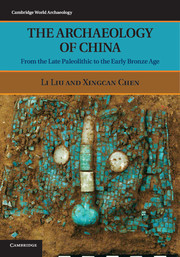Book contents
- Frontmatter
- Contents
- Illustrations
- Tables
- Preface
- Chapter 1 Chinese archaeology: Past, present, and future
- Chapter 2 Environment and ecology
- Chapter 3 Foragers and collectors in the Pleistocene-Holocene transition (24,000–9000 cal. BP)
- Chapter 4 Domestication of plants and animals
- Chapter 5 Neolithization: Sedentism and food production in the early Neolithic (7000–5000 BC)
- Chapter 6 Emergence of social inequality – The middle Neolithic (5000–3000 BC)
- Chapter 7 Rise and fall of early complex societies: The late neolithic (3000–2000 BC)
- Chapter 8 Formation of early states in the Central Plain: Erlitou and Erligang (1900/1800–1250 BC)
- Chapter 9 Bronze cultures of the northern frontiers and beyond during the early second millennium BC
- Chapter 10 The late shang dynasty and its neighbors (1250–1046 BC)
- Chapter 11 Chinese civilization in comparative perspective
- Appendix Horse bones in faunal assemblages from Neolithic and early Bronze Age sites in north China
- Glossary
- References
- Index
Chapter 7 - Rise and fall of early complex societies: The late neolithic (3000–2000 BC)
Published online by Cambridge University Press: 05 June 2012
- Frontmatter
- Contents
- Illustrations
- Tables
- Preface
- Chapter 1 Chinese archaeology: Past, present, and future
- Chapter 2 Environment and ecology
- Chapter 3 Foragers and collectors in the Pleistocene-Holocene transition (24,000–9000 cal. BP)
- Chapter 4 Domestication of plants and animals
- Chapter 5 Neolithization: Sedentism and food production in the early Neolithic (7000–5000 BC)
- Chapter 6 Emergence of social inequality – The middle Neolithic (5000–3000 BC)
- Chapter 7 Rise and fall of early complex societies: The late neolithic (3000–2000 BC)
- Chapter 8 Formation of early states in the Central Plain: Erlitou and Erligang (1900/1800–1250 BC)
- Chapter 9 Bronze cultures of the northern frontiers and beyond during the early second millennium BC
- Chapter 10 The late shang dynasty and its neighbors (1250–1046 BC)
- Chapter 11 Chinese civilization in comparative perspective
- Appendix Horse bones in faunal assemblages from Neolithic and early Bronze Age sites in north China
- Glossary
- References
- Index
Summary
When Yu assembled the States on mount Tu, there were 10,000 States whose princes bore their symbols of jade and offerings of silk.
Chapter, “Duke Ai, 7th Year” (489 BC), in The Zuo Zhuan (compiled 475–221 BC), translated by James Legge (1960a)禹会诸侯于涂山, 执玉帛者万国。 《左传 · 哀公七年》
During the third millennium BC, intensive farming became widespread along the Yellow and Yangzi River regions, where we also see the highest population densities and the most developed complex societies in the archaeological record. In contrast, hunting-gathering communities, sometimes incorporating low-level food production, appear to have continuously dominated the landscapes in many other areas, such as the Northeast, Xinjiang, most areas in the Tibetan Plateau, and some parts of South China.
In the highly populated regions, some major social changes took place. Most of these societies were hierarchically organized, exchange of prestige goods was a common practice among elite individuals, and intergroup warfare intensified. Political control, ritual power, and material wealth were closely related and concentrated in small groups of elites. Regional centers were frequently built with walled enclosures, and some developed early forms of urbanism with political, religious, and economic functions. In ancient Chinese texts the polities in the Yellow River region have been referred to as “myriad (literally, ‘ten thousand’) states” prior to the first dynasty, the Xia.
- Type
- Chapter
- Information
- The Archaeology of ChinaFrom the Late Paleolithic to the Early Bronze Age, pp. 213 - 252Publisher: Cambridge University PressPrint publication year: 2012

